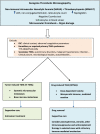Thrombotic microangiopathy (TMA) in adult patients with solid tumors: a challenging complication in the era of emerging anticancer therapies
- PMID: 35545722
- PMCID: PMC9095052
- DOI: 10.1007/s00520-022-06935-5
Thrombotic microangiopathy (TMA) in adult patients with solid tumors: a challenging complication in the era of emerging anticancer therapies
Abstract
Thrombotic microangiopathy (TMA) is a syndrome that encompasses a group of disorders defined by the presence of endothelial damage leading to abnormal activation of coagulation, microangiopathic hemolytic anemia and thrombocytopenia, occlusive (micro)vascular dysfunction, and organ damage. TMA may occur in patients with malignancy as a manifestation of cancer-related coagulopathy itself or tumor-induced TMA (Ti-TMA) as a paraneoplastic uncommon manifestation of Trousseau syndrome. TMA can also be triggered by other overlapping conditions such as infections or more frequently as an adverse effect of anticancer drugs (drug-induced TMA or Di-TMA) due to direct dose-dependent toxicity or a drug-dependent antibody reaction. The clinical spectrum of TMA may vary widely from asymptomatic abnormal laboratory tests to acute severe potentially life-threatening forms due to massive microvascular occlusion. While TMA is a rare condition, its incidence may progressively increase within the context of the great development of anticancer drugs and the emerging scenarios in supportive care in cancer. The objective of the present narrative review is to provide a general perspective of the main causes, the key work-up clues that allow clinicians to diagnose and manage TMA in patients with solid tumors who develop anemia and thrombocytopenia due to frequent overlapping causes.
Keywords: Cancer-associated coagulopathy; Cancer-associated thrombocytopenia; Thrombotic microangiopathy.
© 2022. The Author(s), under exclusive licence to Springer-Verlag GmbH Germany, part of Springer Nature.
Conflict of interest statement
The authors declare no competing interests.
Figures
Similar articles
-
Thrombotic Microangiopathy in Cancer.Semin Thromb Hemost. 2019 Jun;45(4):348-353. doi: 10.1055/s-0039-1687893. Epub 2019 Apr 30. Semin Thromb Hemost. 2019. PMID: 31041804 Review.
-
Thrombotic microangiopathy with targeted cancer agents.Clin Cancer Res. 2011 Sep 15;17(18):5858-66. doi: 10.1158/1078-0432.CCR-11-0804. Epub 2011 Aug 3. Clin Cancer Res. 2011. PMID: 21813634 Free PMC article. Review.
-
Microangiopathy in Cancer: Causes, Consequences, and Management.Cancer Treat Res. 2019;179:151-158. doi: 10.1007/978-3-030-20315-3_10. Cancer Treat Res. 2019. PMID: 31317486
-
Quinine-Induced Thrombotic Microangiopathy: A Report of 19 Patients.Am J Kidney Dis. 2017 Nov;70(5):686-695. doi: 10.1053/j.ajkd.2017.05.023. Epub 2017 Aug 3. Am J Kidney Dis. 2017. PMID: 28780041
-
How I treat microangiopathic hemolytic anemia in patients with cancer.Blood. 2021 Mar 11;137(10):1310-1317. doi: 10.1182/blood.2019003810. Blood. 2021. PMID: 33512445 Free PMC article. Review.
Cited by
-
Bevacizumab-induced immune thrombocytopenia in an ovarian cancer patient with mixed connective tissue disease: case report and literature review.Front Immunol. 2024 Jun 5;15:1382964. doi: 10.3389/fimmu.2024.1382964. eCollection 2024. Front Immunol. 2024. PMID: 38903494 Free PMC article. Review.
-
Solid Tumors, Liquid Challenges: The Impact of Coagulation Disorders.Hematol Rep. 2025 Feb 5;17(1):8. doi: 10.3390/hematolrep17010008. Hematol Rep. 2025. PMID: 39997356 Free PMC article. Review.
-
Nephrotoxicity associated with anticancer agents: perspective on onconephrology from nephrologists.Int J Clin Oncol. 2023 May;28(5):625-636. doi: 10.1007/s10147-023-02307-z. Epub 2023 Mar 5. Int J Clin Oncol. 2023. PMID: 36872414 Review.
-
Surufatinib-induced renal thrombotic microangiopathy: first case report and review of literature.Virchows Arch. 2023 Oct;483(4):561-567. doi: 10.1007/s00428-023-03545-2. Epub 2023 Apr 26. Virchows Arch. 2023. PMID: 37101053 Free PMC article. Review.
-
A rare complication of thrombotic microangiopathy induced by chemotherapy for second breast cancer in a Hodgkin lymphoma survivor: a case report.AME Case Rep. 2025 Jul 15;9:94. doi: 10.21037/acr-24-247. eCollection 2025. AME Case Rep. 2025. PMID: 40761194 Free PMC article.
References
-
- Scully M, Cataland S, Coppo P, de la Rubia J, Friedman KD, Kremer Hovinga J, Lämmle B, Matsumoto M, Pavenski K, Sadler E, Sarode R, Wu H. International Working Group for Thrombotic Thrombocytopenic Purpura. Consensus on the standardization of terminology in thrombotic thrombocytopenic purpura and related thrombotic microangiopathies. J Thromb Haemost. 2017;15:312–322. doi: 10.1111/jth.13571. - DOI - PubMed
-
- Moschcowitz E. Hyaline thrombosis of the terminal arterioles and capillaries: a hitherto undescribed disease. Proc N Y Pathol Soc. 1924;24:21–24.
Publication types
MeSH terms
Substances
LinkOut - more resources
Full Text Sources
Medical


